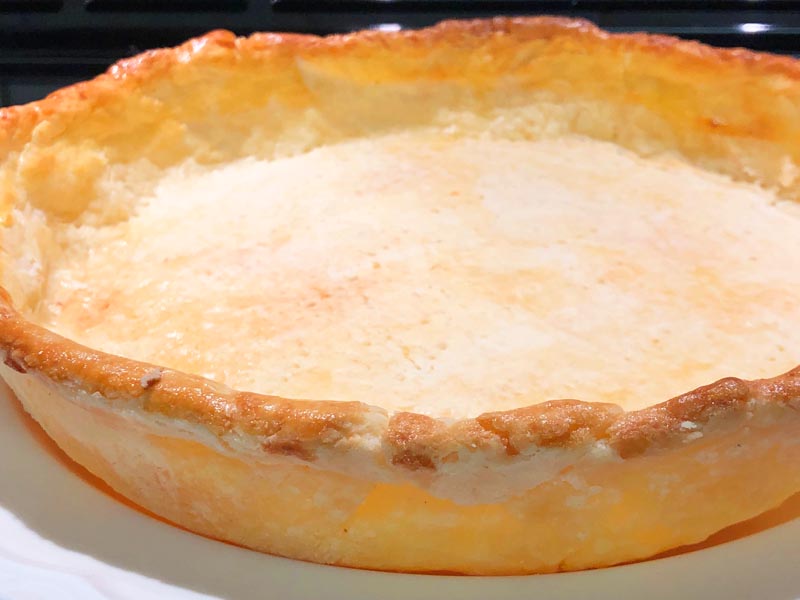I found the secrets to a nice golden brown and tender gluten free pie crust. The two added ingredients are in most kitchens and pantries. Find out what other added ingredients can do to achieve the results you desire.
Watch the video here.
Using vinegar makes pie crusts more tender. If you have a tendency to over-mix your dough, which makes dough tough, you should add in a little vinegar to your recipe.
I’ve added baking powder in the past when a professional chef suggested it to make pie crust more crunchy. You would think that the bubbles it creates (the rise in the dough) would be similar to vinegar, but it isn’t. Vinegar creates a more tender crust. See the below recipe for adding vinegar and for baking powder, see the Blind Baked Gluten Free Pie Crust Recipe. Note that using baking soda would create a crunchy crust much like a cookie.
Why I Never Used Vinegar in the Past
The only way to add vinegar to a pie crust and evenly distribute it is by adding water. Water is what makes pie dough tough. At least too much water makes pie dough tough. I much prefer to add additional butter to a pie crust recipe to make it pliable, moist, and tender rather than water. However, additional butter creates a very tender crust. If you want a medium tender crust, one that is sturdy enough for a double-crusted pie, adding a little water is the way to go. Just don’t add more than you absolutely need. Your ingredients shouldn’t be completely mixed to form one mass. You’ll want some flour or small pieces of dough after mixing. Then, you’ll push them together right before you roll out the dough.
Egg Yolk’s Role in Dough
Egg yolk aids in browning dough whether you fry or bake the dough. I replaced 1 tablespoon of butter that I normally use in my baking powder pie crust with 1 egg yolk, thus switching fat for fat. I love the color of the crust as well when it contains egg yolk.
Crust Edges
If I knew this crust was going to turn out perfectly the first try, I would have made the crust edges prettier. I look forward to writing an article all about the ways of edging a pie crust. The ideas are truly endless: braids, cut outs like leaves, scalloped, using the edge of a spoon to indent half circles all the way around, and of course, crimping with a fork, to name just a few.
Alternative to Egg Yolk & Cream for Egg Wash:
To brown the edges more than they would without anything on them, the ingredients that will result in the darkest crust is a mixture of heavy cream and egg yolk. From dark to light, see the below alternatives:
Egg yolk and whole milk
Whole egg and cream
Whole egg yolk and milk
Egg yolk and water
Whole egg and water
Egg white and cream
Egg white and whole milk
Egg white and water
Keep in mind that you if you use a milk lower in fat, they too will result in a little lighter crust, the less fat they contain.
Tender Gluten Free Pie Crust
Ingredients
For the Pie Crust:
- 1-1/4 cups sweet rice flour 161g
- 1/4 cup potato starch 38g
- 1/4 cup tapioca flour* 29g (or cornstarch)
- 2 teaspoons granulated sugar**
- 1-1/4 teaspoons xanthan gum
- 1/4 + 1/8 teaspoon salt
- 9 tablespoons 1 stick + 1 tablespoon cold, unsalted butter, cut into tablespoons and then into fourths (or half dairy-free buttery sticks Earth Balance and half organic palm oil shortening - Spectrum)
- 2-1/2 tablespoons ice water or as needed (the less the better)
- 1 large egg yolk (or 1 additional tablespoon butter/margarine)
- 1 teaspoon apple cider vinegar
For the Egg Wash (Optional):
- 1 egg yolk
- 1 tablespoon heavy whipping cream (optional)
Instructions
-
In a small or large food processor or medium-sized bowl, combine the sweet rice flour, potato starch, cornstarch, sugar, xanthan gum, and salt. (Reserve 1/4 cup for dusting. You may only need 2 tablespoons.)
-
Add the cold butter pieces to the bowl or your food processor and pulse on the chop setting until meal forms. If using a bowl, smear the butter.
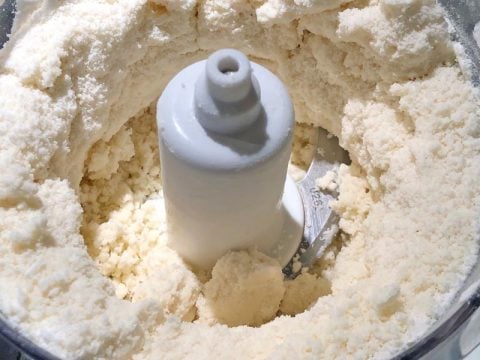
-
Mix together 3 tablespoons of ice water, egg yolk, and vinegar; add to the bowl of dry ingredients. If using a food processor, pulse until the dough starts to come together and you still have a little loose flour left in the bowl. Add additional water by the 1/2 teaspoon if necessary, pulsing between additions. If you are mixing by hand, knead the wet mixture into the dough until the dough just comes together. (Do not over mix or the crust will become tough.)
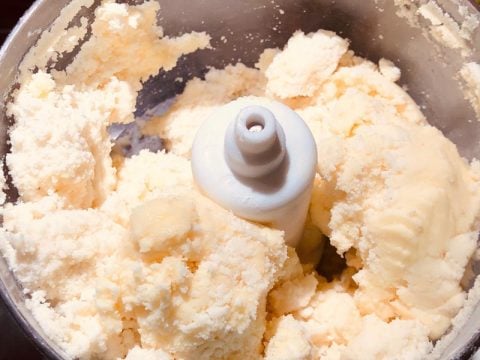
-
Dust a flat surface with at least 2 tablespoons of the reserved flour mixture. Turn out the dough onto the floured surface and immediately gather into a ball. If the dough is too dry, knead in 1/2 teaspoon at a time of water until the dough is moist and much like fresh PlayDough.

-
Roll the dough out large enough to line your pie plate and create a scalloped edge, about 14-inches in diameter if your baking dish is 9 inches in diameter and 2 inches high (9 inches for the bottom + 2 inches for each side, plus an additional inch for tucking under the edges - half inch each side). (See video.)
-
Dust away any excess flour and invert over the pie dish. If you used a silicone baking mat to roll out your dough, you can roll up the crust and then unroll it over the pie dish. (See video.) Gently move it into place and press it into the dish. Turn under the excess edges and smooth out and design as you desire (scalloped, plain, crimped with a fork, or use the tip of a spoon turned over to create curved lines.
-
Using a fork, poke several holes in the bottom of the crust. Don't miss the areas where the sides meet the bottom of the pan.
-
Place a lightly oiled sheet of parchment paper, oil side down onto the dough in the pie dish. Fill with dried beans, dried long grain rice (not instant), or pie weights. (I often use a 7-1/2-inch springform pan and add dried beans around the pan.) Cut the paper down as to expose the crust edges. Freeze for 15 minutes.
-
Preheat your oven to 425°F.
-
Without any filing, bake on the center shelf of the oven for 15 minutes.
-
Remove from the oven and as an option, you may baste the bottom of the crust with egg white, which seals any cracks and prevents the crust from becoming soggy once filled. Egg white also aids in light browning. Baste the edges of the pie crust with a mixture of egg yolk and cream (if using). (For egg-free, brush with oil. Ideally, use a mixture of coconut milk and oil.)
-
If you are making a pie where the filling needs to be baked such as custard, add the filling at this time.
-
Bake the pie crust on the center rack, rotating the pan to encourage even browning, 15 minutes or until the edges are nicely golden brown. (If you've added a filling and it needs to bake longer, cover the crust edges with a silicone pie crust ring or aluminum foil.)
-
Remove the pie from the oven and allow it to cool on a wire rack until you're ready to add the filling. Once completely cool, you may cover with plastic wrap for up to 1 day or freeze up to one month and defrost at room temperature. At this time, you may also remove the crust from the dish, if desired.
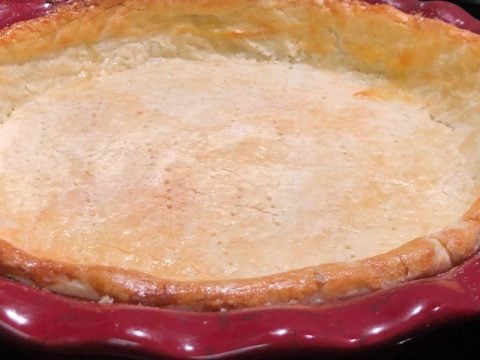
-
Fill the crust with your desired filling, cover, and refrigerate. Alternatively, if you are blind baking (par-baking it once prior to filling with a filling that needs to be baked), fill with your desired filling and bake as instructed by the recipe.
-
Slice, serve, and enjoy. (Note the crust' flakiness.)
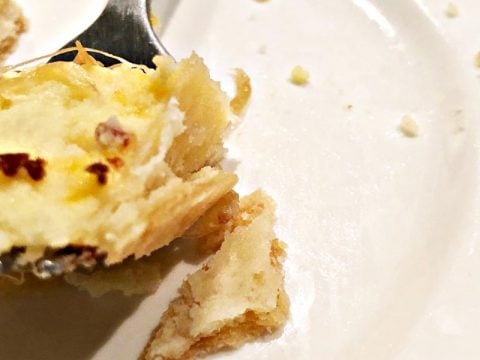
Tips
*Tapioca flour browns better than cornstarch, but cornstarch adds more flavor. **Use as little as 1 teaspoon sugar for savory pies up to 3 teaspoons (1 tablespoon) for sweet


